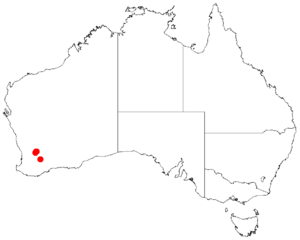Cowan's wattle facts for kids
Quick facts for kids Cowan's wattle |
|
|---|---|
| Conservation status | |
| Scientific classification | |
| Genus: |
Acacia
|
| Species: |
cowaniana
|
 |
|
| Occurrence data from AVH | |
Acacia cowaniana, often called Cowan's wattle, is a type of shrub or small tree. It belongs to the Acacia family, which includes many wattles. This plant is special because it only grows in a small part of southwestern Australia. This means it is endemic to that area.
Contents
About Cowan's Wattle
Cowan's wattle usually grows to be about 1 to 5 meters (3 to 16 feet) tall. Its branches can be smooth or a little bit hairy.
Leaves and Flowers
Like many Acacia plants, Cowan's wattle doesn't have true leaves. Instead, it has what are called phyllodes. These are flattened stems that act like leaves. They are always green and have a narrow, straight shape. Each phyllode is about 2 to 5 centimeters long and 1 to 2.5 millimeters wide. They also have a few faint lines, or nerves, on them.
Cowan's wattle blooms from April to June. During this time, it produces pretty white-yellow flowers.
How it was Named and Classified
The scientific name for Cowan's wattle is Acacia cowaniana. Scientists use a system called taxonomy to name and organize living things.
Discovery and Naming
A botanist named Bruce Maslin first officially described this plant in 1990. He wrote about it in a scientific journal called Nuytsia. The first sample of the plant, called the type specimen, was collected near Jilakin Rock in 1986.
Later, in 2003, another botanist named Leslie Pedley reclassified it. He gave it a new name, Racosperma cowanianum. But in 2006, it was moved back to the Acacia group. So, its official name is still Acacia cowaniana.
Where Cowan's Wattle Grows
Cowan's wattle is native to the Wheatbelt region of Western Australia. It likes to grow near granite rocks, in small patches of soil.
You can only find this plant in a few places. These areas are located between the towns of Kellerberrin and Kulin.


